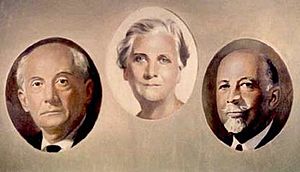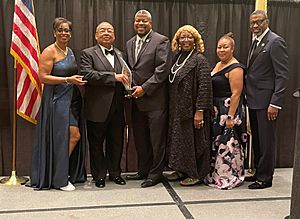NAACP facts for kids
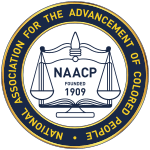 |
|
| Abbreviation | NAACP |
|---|---|
| Formation | February 12, 1909 |
| Founders | W. E. B. Du Bois Mary White Ovington Moorfield Storey Ida B. Wells Lillian Wald Henry Moskowitz |
| Legal status | 501(c)(4) Civic Leagues and Social Welfare Organizations |
| Purpose | "To ensure the political, educational, social, and economic equality of rights of all persons and to eliminate racial hatred and racial discrimination." |
| Headquarters | Baltimore, Maryland, U.S. |
|
Membership
|
300,000 |
|
Chairman
|
Leon W. Russell |
|
President and CEO
|
Derrick Johnson |
|
Main organ
|
Board of directors |
|
Budget
|
$24,800,000 (2019) |
The National Association for the Advancement of Colored People (NAACP) is a very important civil rights group in the United States. It was started in 1909 by both Black and white people. Their main goal was to fight for fairness and justice for African Americans.
Some of the key people who started the NAACP were W. E. B. Du Bois, Mary White Ovington, Moorfield Storey, and Ida B. Wells. Over the years, other famous leaders like Thurgood Marshall and Roy Wilkins have also led the group.
Today, the NAACP works to make sure everyone has equal rights in politics, education, social life, and jobs. They also want to stop all forms of racial discrimination. The NAACP does this by talking to lawmakers, sharing information with the public, and using legal strategies in court. They also work on issues like police misconduct and helping Black refugees.
The name "Colored People" was a common term for people of African descent when the group started. The NAACP still uses this name to honor its history. The NAACP gives out awards each year to African Americans who have done great things. These include the NAACP Image Awards for arts and media, NAACP Theatre Awards for stage work, and the Spingarn Medal for outstanding achievements of any kind. The main office of the NAACP is in Baltimore, Maryland.
Contents
How the NAACP is Organized
The NAACP has its main office in Baltimore, Maryland. It also has other offices in different parts of the U.S., like New York, Michigan, Georgia, Texas, Colorado, and California. These regional offices help to organize the work of state groups. Local groups, and groups for young people and college students, plan activities for members.
A board of 64 members leads the NAACP in the U.S. This board chooses a chairperson, a president, and a chief executive officer. Julian Bond, a well-known civil rights activist, was a chairman.
The NAACP has different departments that focus on specific areas. The "Branch and Field Services" and "Youth and College" departments help local groups. The "Legal" department works on important court cases that affect minorities. This includes fighting discrimination in jobs, government, and schools.
The office in Washington, D.C. talks to the U.S. government to make changes. The Education Department works to make public education better for everyone. The Health Division tries to improve health care for minorities through new policies and education.
Around 2007, the NAACP had about 425,000 members. The NAACP's old records are kept at the Library of Congress. These records show the group's history from when it started until 2003. Many of these documents have been put online. They show the NAACP's work on issues like lynching, school desegregation, and discrimination.
The Niagara Movement: A Step Before the NAACP
Before the NAACP, there was a group called the Niagara Movement. In 1901, there was a big fair in Buffalo, New York. It showed many American achievements. But it also had unfair displays about Black life. Mary Talbert, a Black woman from Ohio, was upset by this. She told W. E. B. Du Bois, and they started to form a group.
In 1905, 32 important African-American leaders met to talk about problems facing Black people. They were worried about Southern states stopping Black people from voting. From 1890 to 1908, Southern states made new laws that made it very hard for Black people to register to vote. This meant most Black people and many poor white people could not vote in the South. White-led governments also passed Jim Crow laws that kept races separate.
Because hotels in the U.S. were segregated, the group met in Canada. They met at the Erie Beach Hotel in Fort Erie, Ontario. This is why they were called the Niagara Movement. A year later, three white people joined: journalist William English Walling, and social workers Mary White Ovington and Henry Moskowitz.
The Niagara Movement faced challenges and ended in 1910. But seven of its members joined the board of the NAACP, which started in 1909. The Niagara Movement was only for African Americans. The NAACP had both Black and white founders.
History of the NAACP
How the NAACP Started
The Springfield Race Riot of 1908 showed how badly a civil rights group was needed. During this time, many Black people, especially men, were being lynched. Mary White Ovington, William English Walling, and Henry Moskowitz met in New York City in January 1909. They wanted to start a group to fight for Black civil rights.
They invited over 60 important Americans to a meeting on February 12, 1909. This date was chosen because it was the 100th birthday of Abraham Lincoln, who freed enslaved African Americans. Even though the first big meeting was later, February 12 is often called the NAACP's founding date.
The NAACP was officially founded by a larger group. This included African Americans like W. E. B. Du Bois, Ida B. Wells, and Mary Church Terrell. White founders included Henry Moskowitz, Mary White Ovington, and William English Walling.
On May 30, 1909, a meeting created the National Negro Committee. Lillian Wald, a nurse, was also a founder. Du Bois helped organize this event. Ida B. Wells-Barnett, a journalist, spoke about lynching and asked for action. The group chose the name "National Association for the Advancement of Colored People." They also chose their first leaders.
The NAACP officially became a non-profit organization in 1911. Its mission was to:
- Make rights equal for all people in the U.S.
- Get rid of prejudice based on race.
- Help Black citizens.
- Make sure they could vote fairly.
- Give them more chances for justice in courts, education, and jobs.
- Make sure everyone was equal under the law.
At first, most of the NAACP's leaders were white. Moorfield Storey, a white lawyer, was the first president. Du Bois was the only African American on the executive board at the start. Du Bois was very important. He edited the group's magazine, The Crisis, which had many readers. The Crisis shared news and published Black poetry and literature.
Jewish people also helped a lot in starting and funding the NAACP.
Fighting Jim Crow Laws

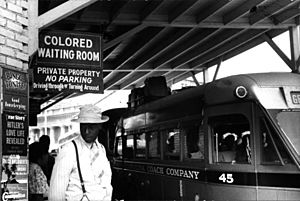
In its early years, the NAACP focused on going to court. They wanted to stop laws that prevented Black people from voting. They also fought against Jim Crow laws. These laws made racial segregation legal, keeping Black and white people separate.
In 1913, the NAACP spoke out against President Woodrow Wilson. He had started separating Black and white workers in federal government offices.
By 1914, the NAACP had 6,000 members and 50 local groups. They helped African Americans become military officers in World War I. The next year, the NAACP led protests across the country against the movie The Birth of a Nation. This film made the Ku Klux Klan look good. Because of the protests, some cities did not allow the movie to be shown.
The NAACP started taking legal action against unfair voting rules and segregation. In 1915, they helped challenge Oklahoma's "grandfather clause" in the case Guinn v. United States. This rule stopped most Black citizens from voting. In 1917, the Supreme Court ruled in Buchanan v. Warley that governments could not officially separate people into different living areas based on race. The NAACP also helped end segregation in fun places, like in the Bob-Lo Excursion Co. v. Michigan case.
In 1916, James Weldon Johnson joined the NAACP. He helped the group grow from 9,000 to almost 90,000 members in four years. In 1920, Johnson became the head of the organization. The NAACP became known around the world for fighting for equal rights for Black Americans.
During the years between the two World Wars, the NAACP spent a lot of time fighting lynching. They worked to pass laws, talked to lawmakers, and taught the public about this issue. The NAACP sent Walter F. White to Arkansas in 1919 to look into the Elaine massacre. In this event, white groups killed many Black farmers. The NAACP helped 12 Black men who were sentenced to death. They showed that the men's confessions were forced. This led to an important Supreme Court decision in Moore v. Dempsey (1923).
The NAACP also tried for over ten years to pass a federal anti-lynching law. But Southern lawmakers blocked it. Because Black people in the South could not vote, they could not elect people who would support them. The NAACP would hang a black flag outside its New York office every time a lynching happened.
The NAACP also fought against "white primary" elections in the South. These were elections where only white people could vote. In 1944, the Supreme Court ruled against the white primary in Smith v. Allwright. Even though these laws were removed, states found new ways to stop Black people from voting.
During the Second Red Scare, some politicians tried to link the NAACP to Communism. To show they were not connected, the NAACP removed members who were thought to be Communists.
Legal Defense Fund
In 1939, the NAACP created the Legal Defense Fund. This group focused on legal cases and helped the NAACP with its legal work. In 1957, it became a separate group.
Ending Segregation
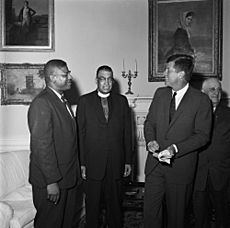
By the 1940s, federal courts were more open to hearing cases about constitutional rights. The NAACP's legal team, led by Charles Hamilton Houston and Thurgood Marshall, worked for many years to overturn the "separate but equal" rule. This rule came from the Supreme Court's decision in Plessy v. Ferguson, which said that separate facilities for Black and white people were okay as long as they were equal.
The NAACP's Baltimore group, led by Lillie Mae Carroll Jackson, challenged segregation in Maryland schools. This led to the 1935 Murray v. Pearson case. Houston's win in Missouri ex rel. Gaines v. Canada (1938) led to the Legal Defense Fund being created.
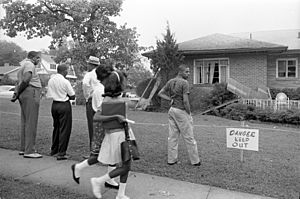
The fight against segregation ended with a big Supreme Court decision in 1954: Brown v. Board of Education. The Court said that state-sponsored segregation in public elementary schools was against the Constitution. After this win, the NAACP pushed for full desegregation across the South.
NAACP activists helped organize a bus boycott in Montgomery, Alabama, starting in December 1955. This protest was against segregation on city buses. The boycott lasted 381 days. In 1956, South Carolina tried to make teachers take an anti-NAACP oath. Teachers who refused lost their jobs. In Alabama, the state tried to stop the NAACP from working there. They wanted a list of members, but the NAACP worried members would be fired or hurt. The Supreme Court later overturned Alabama's action in NAACP v. Alabama (1958).
New groups like the Southern Christian Leadership Conference (SCLC) and the Student Nonviolent Coordinating Committee (SNCC) started using different ways to protest. They used direct action and large protests instead of just lawsuits. Roy Wilkins, the NAACP's leader, sometimes disagreed with Martin Luther King Jr. about how to lead the movement.
The NAACP kept using the Brown decision to push for desegregation in schools and public places. Daisy Bates, who led the Arkansas NAACP, helped the Little Rock Nine to integrate public schools in Little Rock, Arkansas.
By the mid-1960s, the NAACP became very important again by pushing for civil rights laws. The March on Washington for Jobs and Freedom happened on August 28, 1963. Later that year, President John F. Kennedy sent a civil rights bill to Congress.
President Lyndon B. Johnson worked hard to pass a civil rights bill. This bill aimed to end racial discrimination in jobs, education, and public places. It passed in July 1964. He then helped pass the Voting Rights Act of 1965. This law protected the right to vote, especially in places where few Black people had been allowed to vote.
The FBI's COINTELPRO program tried to disrupt civil rights groups, including the NAACP.
Kivie Kaplan became NAACP President in 1966. After he died in 1975, W. Montague Cobb took over. Roy Wilkins retired in 1977, and Benjamin Hooks became the new leader.
The 1990s and Beyond
In the 1990s, the NAACP faced financial problems. Rupert Richardson became president in 1992. In 1993, Benjamin Chavis became Executive Director but was removed 18 months later. After this, Myrlie Evers-Williams became president in 1995.
In 1996, Congressman Kweisi Mfume became the organization's president. Three years later, money problems forced the NAACP to cut its staff.
In the late 1990s, the group improved its finances. This allowed the NAACP National Voter Fund to help get out the vote in the 2000 U.S. presidential elections. Over 10 million African Americans voted, which was one million more than four years before. Many people said the NAACP's efforts helped Al Gore win several states.
In 2004, President George W. Bush did not speak at the NAACP's national convention. His spokesperson said it was because of strong words used by NAACP leaders about him. In 2006, Bush did speak at the convention. He tried to get more support for Republicans from African Americans.
In October 2004, the Internal Revenue Service (IRS) looked into the NAACP's tax-exempt status. This was because of a speech by chairman Julian Bond that criticized President George W. Bush. Groups with tax-exempt status are not allowed to get involved in political campaigns. The NAACP said this investigation was unfair. In 2006, the IRS said the speech did not break any rules.
LGBT Rights
As the movement for LGBT rights grew, the NAACP became more involved. While chairman, Julian Bond openly supported the rights of gay and lesbian people. He also supported same-sex marriage. He even refused to attend Coretta Scott King's funeral because he felt her children had chosen an anti-gay church.
In 2007, Bond said, "If you don't like gay marriage, don't get gay married." His views sometimes caused disagreements between the NAACP and some religious groups.
On May 19, 2012, the NAACP's board officially supported same-sex marriage as a civil right. They voted 62–2 for this policy. Benjamin Jealous, the president, said that marriage equality is a civil right. He said the NAACP's support came from the 14th Amendment, which ensures equal protection for all people.
Travel Warnings
On June 7, 2017, the NAACP warned African-American travelers about visiting Missouri. They said there was a long history of race-based crimes there. They also mentioned a new law that could make it harder for people to fight discrimination. The NAACP suggested that visitors to Missouri should have "bail money."
In May 2023, the NAACP and other groups issued travel warnings for Florida. This was because of new laws that they said targeted people of color and LGBTQ+ individuals. They stated that Florida's governor had attacked Black Americans, Black history, voting rights, and other groups.
Censorship
The NAACP led protests against the 1915 film The Birth of a Nation. In 2019, the NAACP asked for all Dr. Seuss books to be banned from public schools and libraries. They said the books showed discriminatory images of different groups of people. In 2023, the group sued to stop a book from being banned from school libraries.
Local Impact of the NAACP
The NAACP's national office handles big campaigns, talks to lawmakers, and shares information. Their legal team works on court cases.
But the local NAACP groups have also been very important. When the national office protested The Birth of a Nation, local groups organized boycotts. When the group fought to stop lynching, local groups took the message to many communities. While the Legal Defense Fund worked on federal court cases, many local groups fought discrimination using state laws. They sometimes won important victories.
These wins mostly happened in Northern and Western states before World War II. When the civil rights movement grew in the South, both the Legal Defense Fund lawyers and the many local groups helped. These local groups helped build a culture where Black people were active in politics.
What the NAACP Does Today
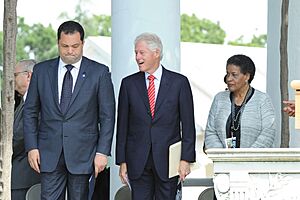
Youth Programs
The NAACP started youth sections in 1936. Now, there are over 600 groups with more than 30,000 young people. The NAACP Youth & College Division is where young people can get involved. Youth Councils are made up of high school and college students. They share their ideas and work on local and national issues.
Youth and College Division Mission
The goal of the NAACP Youth & College Division is to teach young people about problems affecting African Americans and other minorities. They want to improve the economic, educational, social, and political standing of these groups. They also want to help different people work together. They aim to help young people appreciate African history and culture. Finally, they want to develop smart and strong young leaders.
ACT-SO Program
Since 1978, the NAACP has run the Afro-Academic, Cultural, Technological and Scientific Olympics (ACT-SO) program. This program is for high school students across the U.S. It celebrates and rewards young African Americans who are good at academics, technology, and the arts. Local groups hold competitions in different areas. Winners can go to a national event each summer. National winners get recognition, money, and prizes.
Environmental Justice
The NAACP has a group that works on environmental justice. This group has 11 full-time staff members. In April 2019, the NAACP released a report about how fossil fuel companies work. The report said that these companies try to influence the NAACP. The NAACP has been concerned that utility companies give money to NAACP groups. In return, these groups might support goals that are not good for the environment. The NAACP is now working with its groups to encourage them to support environmentally friendly policies.
Headquarters Relocation
On June 29, 2020, a news radio station reported that the NAACP planned to move its main office. It would move from Baltimore to Washington, D.C. Derrick Johnson, the NAACP's president, said that being in D.C. would help the group make more changes.
National Convention
The NAACP holds its national convention every year in different cities:
- 1909: New York City
- 1910: New York City
- 1928: Los Angeles
- 1929: Cleveland
- 1954: Dallas
- 1980: Miami Beach, Florida
- 1981: Denver
- 1982: Boston
- 1983: New Orleans
- 1984: Kansas City, Missouri
- 1985: Dallas
- 1986: Baltimore
- 1987: New York City
- 1988: Washington, D.C.
- 1989: Detroit
- 1990: Los Angeles
- 1991: Houston
- 1992: Nashville, Tennessee
- 1993: Indianapolis
- 1994: Chicago
- 1995: Minneapolis
- 1996: Charlotte, North Carolina
- 1997: Pittsburgh
- 1998: Atlanta
- 1999: New York City
- 2000: Baltimore
- 2001: New Orleans
- 2002: Houston
- 2003: Miami
- 2004: Philadelphia
- 2005: Milwaukee
- 2006: Washington, D.C.
- 2007: Detroit
- 2008: Cincinnati
- 2009: New York City
- 2010: Kansas City, Missouri
- 2011: Los Angeles
- 2012: Houston
- 2013: Orlando, Florida
- 2014: Baltimore
- 2015: Philadelphia
- 2016: Cincinnati
- 2017: Baltimore
- 2018: San Antonio
- 2019: Detroit
- 2020: Virtually
- 2021: Virtually
- 2022: Atlantic City, New Jersey
- 2023: Boston
Awards Given by the NAACP
- NAACP Image Awards – These awards honor African-American achievements in movies, TV, music, and books.
- NAACP Theatre Awards – These awards honor African-American achievements in theater and stage plays.
- Spingarn Medal – This medal honors outstanding achievements by African Americans in any field.
-
Thalheimer Award – This award is for achievements by NAACP local groups.
- Montague Cobb Award – This award honors African-American achievements in health.
- Nathaniel Jones Award for Public Service – This award started in 2018 and is given to public servants.
- Foot Soldier In the Sands Award – This award is given to lawyers who have given their legal help to the NAACP for free.
- Juanita Jackson Mitchell Award for Legal Activism – This award is given to an NAACP group for excellent legal work.
- William Robert Ming Advocacy Award – This award is given to lawyers who show personal and financial sacrifice for human equality.
See also
 In Spanish: National Association for the Advancement of Colored People para niños
In Spanish: National Association for the Advancement of Colored People para niños
- Althea T. L. Simmons, NAACP attorney
- Civil rights movement (1896–1954)
- The Crisis, official magazine
- Niagara Movement
- Racial integration


